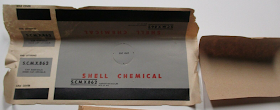Zanesville, Ohio, April 7, 1956
This photo has always appealed to me. The low angle of both the lighting and photographic perspective afford a great view of the numerous details, including the distorted plate steel of the sides, as well as the weirdly arranged AB brake components (it is rare to see brake components arranged with the piping facing out towards the side of the car, rendering it vulnerable to damage.) Additionally, the load of large diameter pipe makes for a compelling prototypical lading to replicate, including the banding, wire, and hardwood dimensional lumber containment pieces. Lastly, as a rebuilt car, it represents an interesting modeling subject. It started life as a Caswell-type gondola before rebuilding with tight, solid wood floors, elimination of the GS drop doors, and replacement Dreadnaught ends.
The photo below illustrates what the cars looked like prior to rebuilding. I do not have photos of the cars as built, but it is my assumption that the Wine door locks were not in place when the cars were new circa 1912. This car was reweighed at the Danville shops in June, 1927.
In late 1951, there were 251 of the rebuilt cars in the 95000-95299 series plus an additional 45 cars in the same series, but equipped for auto frame loading. The 90000-90199 series had 200 rebuilds like C&EI 95643 shown above except they still had drop doors and Wine door locks. There were also still 327 cars like the one below in series 92000-94499. The cars that were still of composite construction could be kitbashed using Intermountain bodies with Westerfield Wine door locks and angle stock for the part attached to the drop doors that the locks secure in place. That totals 823 of these interesting gons in service in late 1951.
Pine Village, Indiana, circa 1928, Allen and Son photo






































